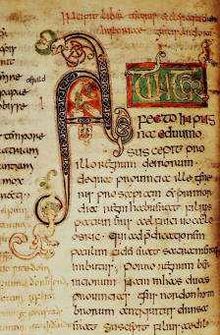Tiberius Bede

British Library, MS Cotton Tiberius C. II, or the Tiberius Bede, is an 8th-century illuminated manuscript of Bede's Historia ecclesiastica gentis Anglorum. It is one of only four surviving 8th-century manuscripts of Bede, another of which happens to be MS Cotton Tiberius A. XIV, produced at Monkwearmouth–Jarrow Abbey.[1] As such it is one of the closest texts to Bede's autograph. The manuscript has 155 vellum folios. This manuscript may have been the Latin text on which the Alfredian Old English translation of Bede's Ecclesiastical History was based. The manuscript is decorated with zoomorphic initials in a partly Insular and partly Continental style. The manuscript has given its name to the 'Tiberius' group of manuscripts, connected on stylistic grounds and sometimes also known as the 'Canterbury' group, though the region of their production remains unknown – Mercia has also been suggested.
Notes
References
- M.Brown, 'The 'Tiberius' Group and its historical context', in M.Brown and C.Farr (eds.) Mercia – an Anglo-Saxon kingdom in Europe (Leicester, 2001), pp. 278–294.
